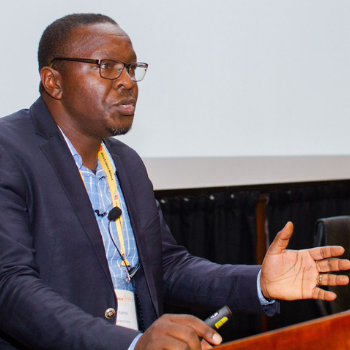Traditional storytelling audit feedback by eBASE Africa
“Storytelling is our obligation to the next generation. If all we are doing is marketing, we are doing a disservice, and not only to our profession, but not to our children, and their children. Give something of meaning to your audience by inspiring, engaging, and educating them with story. Stop marketing, start storytelling.” ---- Laura Holloway
eBASE Africa highlighted some engagements with government agencies in francophone countries for equitable research use, but also through and with local traditional story tellers for wider dissemination of research evidence. They have also worked with practitioners like teachers to make use of audit feedback to improve teaching and learning capacities.
Take any group of people and their response to phrases like ‘Once upon a time…’, ‘I want to tell you a story…’ or even just ‘Listen…’ is the same. We are programmed to respond to storytelling, an expectation of entertainment, information and shared experience linked to these cues. Psychologists recognize the key role that storytelling plays as a particularly powerful form of communication, linked to our emergence and survival as social animals. The image of the bard as a mixture of entertainer and informer, carrying important messages and broadcasting them across a population is well-established in history, and although the media may have changed the underlying power of stories remains.
Storytelling helps to transfer information between individuals and to gain legitimacy for key actions or support for particular projects. Stories also provide an organizational memory enabling and facilitating learning from the past to inform and shape the future (Garud, 2013; Strambach and Klement, 2012).
The problem/Challenge
Despite the ever-growing body of research, the evidence ecosystem is faced with the problem of evidence to practice gap. Some of the challenges associate to the limited uptake of research evidence is the Complexity of research evidence terminology, limited access to research evidence, the language in which the research evidence is disseminated, limited funding of innovative knowledge mobilization approaches etc. To ensure the effective uptake of research evidence by targeted population, it is important to consider what, to whom, by whom and how should research be transferred. Understanding the dynamicity (Non-scientific savvies, non-literate, non-digital literate, resources constraints inhabitants with limited access to media, hundreds of languages spoken etc) of the different populations is a great step in knowledge mobilization for an equitable use of research evidence for decision making by all.
The Goal
The goal of the storytelling events is to disseminate knowledge in a digestible form that relates to people of all background (young, old, scientific, non-scientific, non-literate, non-digital literate, different languages, and people in resource constraint areas with no access to any form of media.
The solution
In the context of innovation, storytelling plays a key role both in terms of developing shared understanding and experience and also as a valuable tool to enable the process of introducing change. Storytelling is the vivid description of ideas, beliefs, personal experiences, and life- lessons through stories or narratives that evoke powerful emotions and insights (Serrat 2008). The African tradition of storytelling a mechanism to pass on traditions, codes of behaviour, beliefs, to educate, transmit values, worldviews, expectations, cultures, myth, entertain, empower, motivate, maintaining social order and to keep information alive from one generation to the other. (P. K. al 2008, Tuwe 2016).
The added value of storytelling to the scientific way of communicating with graphs, tables, forest plots, figures and charts(still very complex even for scientists) is that Storytelling is done in hundreds different languages, communicate to populations with different background, transfer knowledge in a digestible form, communicate facts in a non-confrontational way, appeal to the emotions of the listener while at the same time, entertaining the audience, Stories have causality in its communication (cause and effect) which makes stories stick, more persuasive for behaviour change as audience quickly identify themselves in the life of the characters “People forget facts but they remember stories ” I quote Joseph Campbell “Facts don't persuade, feelings do. And stories are the best way to get at those feelings” I quote Tom Asacker.
This approach has been used to sensitize children; indigenous people living in resource constraint areas with limited access to information; non-digital citizens with limited capacity to access reliable information online and the general public at large. This approach has been used to sensitize citizens around sexual and gender-based violence, peace and reconciliation, menstrual hygiene management, malaria, environmental protections, and covid 19 protective and preventive measures.
Results
- The storytelling approach has been used in developing our child protection song which has impacted over 50,000 children in schools in the far north region, east regions, northwest region and south west region of Cameroon. This song helped the children living in conflict affected areas of Cameroon to recognize and respond to child sexual abuse.
- The same storytelling approach has been used to improve the knowledge of indigenous citizens on menstruation literacy, fight myth and cultural stereotypes around menstruation. This was with the aim of improving school attendance of 10,000 adolescent girls in 15 schools in 3 regions of Cameroon (east, north and far north)
- Our systematic storytelling approach has also been used in communicating COVID-19 recommendations from Covid-19 RecMap to 2000 non-digital citizens of Cameroon
- This same approach has been the focus of a training with the government of Western Cape South Africa and the South Africa Centre for Evidence to solve Urbanization challenges in Cape Town.
Paul Smith (Lead with a story book):
Some of the most successful companies in the world use storytelling very intentionally as a leadership tool. Organizations like Microsoft, Motorola, Berkshire Hathaway, Saatchi & Saatchi, Procter & Gamble, NASA, and the World Bank are among them (Smith, 2012). They do this in several ways. Some have a high level corporate storyteller whose job it is to capture and share their most important stories. At Nike, in fact, all the senior executives are designated corporate storytellers (Smith, 2012).
CEO, International construction engineering enterprise
“I think storytelling is really important. But storytelling is more important today because we do not have data and systems. So the only way of passing experience and knowledge is through storytelling. And only some people are good at storytelling, not everyone is. If you are good at recording the information in a consistent way everyone gets access to it because you came across a good storyteller and they helped you learn. So, I think storytelling is one of the things that have helped because the other system has not been there to allow information-in-use to be transferred between people.”
Conclusion
The potential of storytelling as an innovative tool for capacity building can never be overemphasized as it preserves and shares information to new people. Storytelling is seen to provide organizational memory which enables people to translate emergent ambiguous situations into the meaningful present and future. They help to capture lessons learnt from previous failures and successes and transfer knowledge. Senior managers use stories repetitively to make employees follow common vision.


